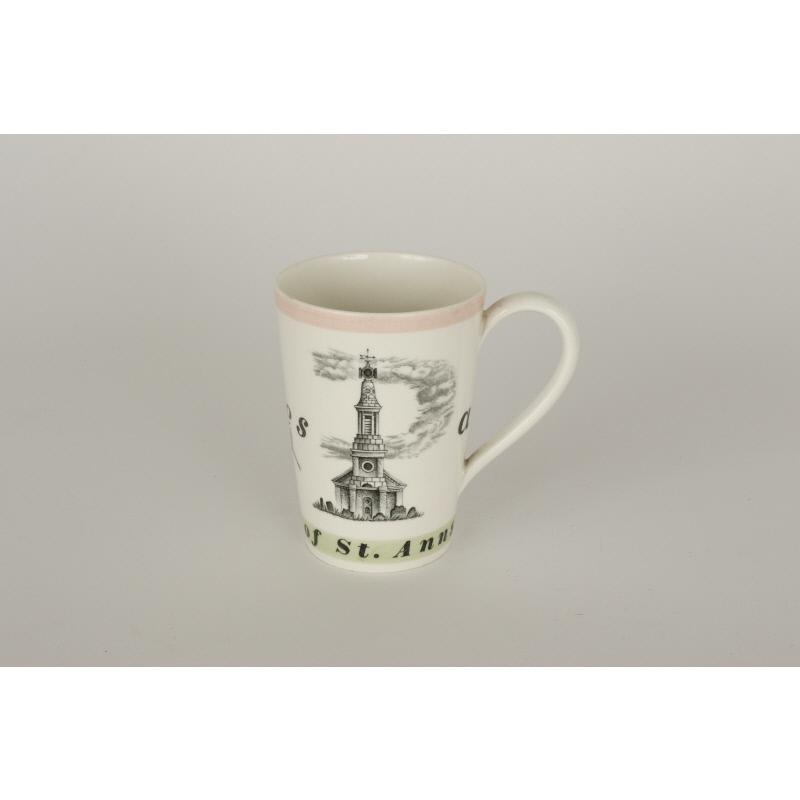Cup
Classification(s):
Pottery
Date: c. 1951-1976
Organisation: Wedgwood (English, founded 1759)
Organisation: Liberty (English, founded 1875)
Dimensions:
105 × 130 mm (10.5 × 13 cm)
Medium: Earthenware
Object number: P372A
See Also
Place of Production:England
DescriptionGlazed earthenware cup with handle, manufactured by Wedgwood for Liberty & Co. The cup has a transfer-printed decoration, designed by Richard Guyatt. The design features illustrated text, which reads, “Kettles and Pans say the bells of St. Anns”. The ‘K’ of Kettles is formed by the shape of a man leaning on the branch of a tree, from which is hung a kettle and pans. The ‘P’ of Pans is formed by the bell tower of St. Anns church and a thick cloud. The cup has a pink band around the lip.
Back stamp reads, “First made for Liberty’s by Wedgwood Made in England Designed by Richard Guyatt”.
Hand written label to base “Pattern No C6510 Pink & Green Beaker ½ pint handled”.
There is a matching cup represented in the collection (P239A).
Back stamp reads, “First made for Liberty’s by Wedgwood Made in England Designed by Richard Guyatt”.
Hand written label to base “Pattern No C6510 Pink & Green Beaker ½ pint handled”.
There is a matching cup represented in the collection (P239A).
ProvenanceThis object was originally acquired for the Inner London Education Authority’s (ILEA) ‘Circulating Design Scheme’ collection.
The collection was instigated by the London Country Council (later the Greater London Council) and the Council of Industrial Design (COID). The collection’s original purpose was concerned with the teaching and dissemination of modern, ‘good design’.
The collection was established in 1951/52 as the ‘Experiment in Design Appreciation’, later renamed the ‘Circulating Design Scheme’.
The Circulating Design Scheme lent boxed showcases to London schools. The showcases contained handling objects, material samples and interpretation on a specific subject.
COID withdrew its involvement in the Scheme in 1957. After which time, it was managed exclusively by the London County Council from 1957-1963.
After the administrative restructuring of London authorities, the Scheme was jointly managed by the Greater London Council and the Inner London Education Authority (ILEA) from 1963 – 1976.
The Scheme was operational until 1976 when the collections were withdrawn from circulation. ILEA was abolished in the late 1980s and the collection was donated to Camberwell College of Arts in 1989/90.
ILEA was responsible for secondary and tertiary education in the inner London boroughs, this included Camberwell.
The collection was instigated by the London Country Council (later the Greater London Council) and the Council of Industrial Design (COID). The collection’s original purpose was concerned with the teaching and dissemination of modern, ‘good design’.
The collection was established in 1951/52 as the ‘Experiment in Design Appreciation’, later renamed the ‘Circulating Design Scheme’.
The Circulating Design Scheme lent boxed showcases to London schools. The showcases contained handling objects, material samples and interpretation on a specific subject.
COID withdrew its involvement in the Scheme in 1957. After which time, it was managed exclusively by the London County Council from 1957-1963.
After the administrative restructuring of London authorities, the Scheme was jointly managed by the Greater London Council and the Inner London Education Authority (ILEA) from 1963 – 1976.
The Scheme was operational until 1976 when the collections were withdrawn from circulation. ILEA was abolished in the late 1980s and the collection was donated to Camberwell College of Arts in 1989/90.
ILEA was responsible for secondary and tertiary education in the inner London boroughs, this included Camberwell.
NotesAt the age of 19, Richard Guyatt began his career as a graphic designer producing posters for companies like Shell and BP. He co-designed the Lion and Unicorn Pavilion, at the Festival of Britain in 1951. Guyatt is best known for the commemorative mugs he created for Wedgwood, but his designs are ubiquitous and include coins for the Royal Mint, postage stamps, the WH Smith logo and packaging for Anchor butter. He worked at the Royal College of Art for over 30 years. As a professor he aided the reform and relaunch of the institution in 1948. As design professions were beginning to emerge in the post-ware years, the institutions teaching began to reflect this – preparing students for lives as working design professionals. With a focus on industry partnerships, and practitioner-teachers, the new specialist department was to be called the school of graphic design – this was the first instance the phrase ‘graphic design’ had been used in an educational setting, and subsequently encouraged the phrase into popular language









